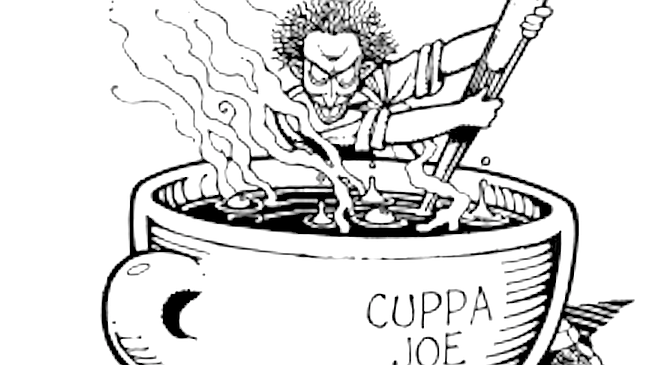 Facebook
Facebook
 X
X
 Instagram
Instagram
 TikTok
TikTok
 Youtube
Youtube

Dear Matthew Alice: This has been bugging me ever since I started stirring hot beverages with a spoon, especially coffee. When I add sugar to my hot coffee and begin stirring it, my spoon taps the side of the ceramic mug, making an expected ring. However, as I continue rapidly stirring and tapping, the tone of the ring changes pitch. My friend Barb suggests that it might be due to the heat's effect on the sound waves. I tend to feel that it has to do with the change in the density of the solution. Neither concept explains why the tone changes gradually. What's the real answer, all-knowledgeable one? — Jimmy, Tierrasanta
Dear Matt: In my morning stupor I spend a lot of time staring into cups of steaming black coffee. So I might be hallucinating but I don't think so. My coffee sometimes looks like it has white or gray cloudy patches floating on the surface. They kind of swirl around sometimes and then disappear.I haven't done anything to it except pour the coffee into the cup. What’s going on? — Mochdhead, San Diego
Follow me back in time. Physics 101: hot things go up, cold things go down. Convection it’s called in liquids and gasses. Your cuppa joe is a silent, roiling mass of convection currents, hot java rising, cool java sinking. When the hotted-up stuffhits the surface, jillions of water molecules leap to freedom from their caffeinated hell into the fresh morning air, creating a mighty updraft. Thus liberated, they cool, condense, materialize as undulating wisps of water droplets hovering like clouds over a tropical sea, held aloft by the relentless stream of molecules escaping your cup. You stare transfixed, mouth agape. The coffee cools, the vapors vanish.’You doze off. Your head falls into your eggs. You’re jolted awake. Your coffee’s too cold to swallow. You wash your face. You go back to bed.
Meanwhile, Jimmy and Barb are fully alert, tingling with curiosity, repeatedly clanking their spoons in their mugs, over and over and over in that aggravating way until you want to lunge across the table and slap them both silly. Lively discussion ensues. Theories are formulated, debated. “It’s density,” says Jimmy. “No, temp,” says Barb. “Ha-ha, you simpletons,” sneer the experts, in this case, the Institute of Geophysics and Planetary Physics at UCSD-Scripps. “We know best. We did the research. It’s air bubbles, you groveling squids.” Sugar, instant coffee, coffee creamer powder all contain trapped air. Sound travels four times slower in air than in water. Slower-moving sound is lower pitched. Ergo: dump stuff into coffee, air released into coffee, stir stir stir stir, air bubbles gradually driven out of beverage, pitch gradually rises. As much as two octaves from even a small amount of air. Don’t believe it? Don’t argue with the IGPP. You’ll lose.


Dear Matthew Alice: This has been bugging me ever since I started stirring hot beverages with a spoon, especially coffee. When I add sugar to my hot coffee and begin stirring it, my spoon taps the side of the ceramic mug, making an expected ring. However, as I continue rapidly stirring and tapping, the tone of the ring changes pitch. My friend Barb suggests that it might be due to the heat's effect on the sound waves. I tend to feel that it has to do with the change in the density of the solution. Neither concept explains why the tone changes gradually. What's the real answer, all-knowledgeable one? — Jimmy, Tierrasanta
Dear Matt: In my morning stupor I spend a lot of time staring into cups of steaming black coffee. So I might be hallucinating but I don't think so. My coffee sometimes looks like it has white or gray cloudy patches floating on the surface. They kind of swirl around sometimes and then disappear.I haven't done anything to it except pour the coffee into the cup. What’s going on? — Mochdhead, San Diego
Follow me back in time. Physics 101: hot things go up, cold things go down. Convection it’s called in liquids and gasses. Your cuppa joe is a silent, roiling mass of convection currents, hot java rising, cool java sinking. When the hotted-up stuffhits the surface, jillions of water molecules leap to freedom from their caffeinated hell into the fresh morning air, creating a mighty updraft. Thus liberated, they cool, condense, materialize as undulating wisps of water droplets hovering like clouds over a tropical sea, held aloft by the relentless stream of molecules escaping your cup. You stare transfixed, mouth agape. The coffee cools, the vapors vanish.’You doze off. Your head falls into your eggs. You’re jolted awake. Your coffee’s too cold to swallow. You wash your face. You go back to bed.
Meanwhile, Jimmy and Barb are fully alert, tingling with curiosity, repeatedly clanking their spoons in their mugs, over and over and over in that aggravating way until you want to lunge across the table and slap them both silly. Lively discussion ensues. Theories are formulated, debated. “It’s density,” says Jimmy. “No, temp,” says Barb. “Ha-ha, you simpletons,” sneer the experts, in this case, the Institute of Geophysics and Planetary Physics at UCSD-Scripps. “We know best. We did the research. It’s air bubbles, you groveling squids.” Sugar, instant coffee, coffee creamer powder all contain trapped air. Sound travels four times slower in air than in water. Slower-moving sound is lower pitched. Ergo: dump stuff into coffee, air released into coffee, stir stir stir stir, air bubbles gradually driven out of beverage, pitch gradually rises. As much as two octaves from even a small amount of air. Don’t believe it? Don’t argue with the IGPP. You’ll lose.
Comments